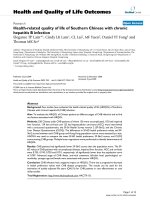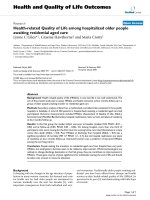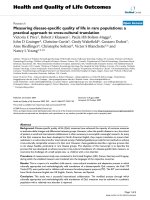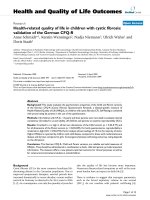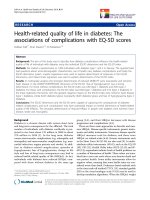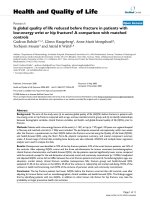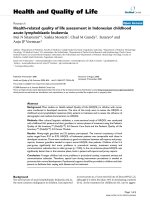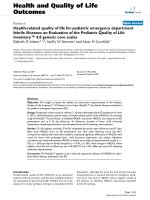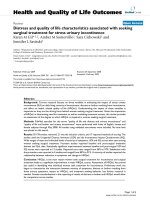báo cáo hóa học:" Measuring disease-specific quality of life in rare populations: a practical approach to cross-cultural translation" docx
Bạn đang xem bản rút gọn của tài liệu. Xem và tải ngay bản đầy đủ của tài liệu tại đây (354.7 KB, 8 trang )
BioMed Central
Page 1 of 8
(page number not for citation purposes)
Health and Quality of Life Outcomes
Open Access
Research
Measuring disease-specific quality of life in rare populations: a
practical approach to cross-cultural translation
Victoria E Price
1
, Robert J Klaassen
2
, Paula HB Bolton-Maggs
3
,
John D Grainger
4
, Christine Curtis
5
, Cindy Wakefield
6
, Gustavo Dufort
7
,
Arne Riedlinger
8
, Christophe Soltner
9
, Victor S Blanchette
5,6
and
Nancy L Young*
5,10
Address:
1
Division of Pediatric Hematology/Oncology, IWK Health Centre, Dalhousie University, Halifax, NS, Canada,
2
Division of Pediatric
Hematology/Oncology, Children's Hospital of Eastern Ontario, Ottawa, ON, Canada,
3
Department of Clinical Hematology, Manchester Royal
Infirmary, Manchester, UK,
4
Royal Manchester Children's Hospital, Manchester, UK,
5
Child Health Evaluative Science, The SickKids Research
Institute, Toronto, ON, Canada,
6
Division of Pediatric Hematology/Oncology, The Hospital for Sick Children, Toronto, ON, Canada,
7
Pediatric
Hemato-Oncology, Centro Hospitalario Pereira Rossell, Montevideo, Uruguay,
8
Department of Pediatrics, Charité - Universitätsmedizin, Berlin,
Germany,
9
Anesthesiology and Surgical Intensive Care Department, University Hospital of Angers, Angers, France and
10
School of Rural and
Northern Health, Laurentian University, Sudbury, ON, Canada
Email: Victoria E Price - ; Robert J Klaassen - ; Paula HB Bolton-Maggs - Paula.Bolton-
; John D Grainger - ; Christine Curtis - ;
Cindy Wakefield - ; Gustavo Dufort - ; Arne Riedlinger - ;
Christophe Soltner - ; Victor S Blanchette - ; Nancy L Young* -
* Corresponding author
Abstract
Background: Disease-specific quality of life (QoL) measures have enhanced the capacity of outcome measures
to evaluate subtle changes and differences between groups. However, when the specific disease is rare, the cohort
of patients is small and international collaboration is often necessary to accomplish meaningful research. As many
of the QoL measures have been developed in North American English, they require translation to ensure their
usefulness in a multi-cultural and/or international society. Published guidelines provide formal methods to achieve
cross-culturally comparable versions of a QoL tool. However, these guidelines describe a rigorous process that
is not always feasible, particularly in rare disease groups. The objective of this manuscript is to describe the
process that was developed to achieve accurate cross-cultural translations of a disease-specific QoL measure, to
overcome the challenges of a small sample size, i.e. children with a rare disorder.
Procedure: A measurement study was conducted in the United Kingdom (UK), France, Germany and Uruguay,
during which the validated measure was translated into the languages of the respective countries.
Results: This is a report of a modified, child-centric, cross-cultural translation and adaptation process in which
culturally appropriate and methodologically valid translations of a disease-specific QoL measure, the Kids' ITP
Tools (KIT), were performed in children with immune thrombocytopenic purpura (ITP). The KIT was translated
from North American English into UK English, French, German, and Spanish.
Conclusion: This study was a successful international collaboration. The modified process through which
culturally appropriate and methodologically valid translations of QoL measures may be achieved in a pediatric
population with a relatively rare disorder is reported.
Published: 23 October 2009
Health and Quality of Life Outcomes 2009, 7:92 doi:10.1186/1477-7525-7-92
Received: 10 August 2009
Accepted: 23 October 2009
This article is available from: />© 2009 Price et al; licensee BioMed Central Ltd.
This is an Open Access article distributed under the terms of the Creative Commons Attribution License ( />),
which permits unrestricted use, distribution, and reproduction in any medium, provided the original work is properly cited.
Health and Quality of Life Outcomes 2009, 7:92 />Page 2 of 8
(page number not for citation purposes)
Introduction
The development of quality of life (QoL) measures has
greatly enhanced the scope of outcomes that can now be
measured by rigorous scientific methods. Their inclusion
in clinical studies enables the assessment of differences
and subtle changes between groups, either due to time or
treatment, which was not previously possible. Changes in
QoL are particularly salient to children and their families.
As the cohort of patients with any rare disorder is small
and even smaller when the focus is specifically children,
international collaboration in the research of such disor-
ders is essential as we work towards evidence-based prac-
tice. Consequently, it is recognised that QoL measures,
many of which have been developed in North American
English, require translation in order to retain their validity
and reliability in a multi-cultural society and internation-
ally.
In order to achieve accurate, cross-culturally comparable
versions, formal methods of translation and adaptation
need to be applied. This process involves both linguistic
translation where the measure is literally translated into
the new language and cultural translation where it is
adjusted appropriately for the cultural context, as well as
an evaluation process to ensure comparability with the
original tool. Several publications have outlined processes
for achieving this cross-cultural adaptation. Guillemin et
al published a report in 1993, in which recommendations
were proposed based on their review of the literature[1].
This was followed by two publications outlining guide-
lines for a comprehensive process of cross-cultural adap-
tation[2,3]. These guidelines and recommendations
require the inclusion of large numbers of subjects across
several countries and extensive use of professional transla-
tors. The recommendations from the published guide-
lines are summarized in Table 1 along with the modified
process that is described in this report. Although these
guidelines provide an excellent frame of reference, they
are based on expert opinion. The best method to use is not
clear. Furthermore, while these guidelines may be applica-
ble when translating and adapting measures for large
cohorts of adults, the process presents unique challenges
when applied to children, and particularly when the
measure is being developed for use in children with a rare
disorder. Examples of such challenges include: 1) the dif-
ficulty in applying the guidelines to a small sample size
(<50 subjects), and 2) the specific needs of children,
including their unique linguistic style, which is difficult
for professional translators to capture.
To determine what was actually practiced in the field of
measurement in the pediatric medical literature, we con-
ducted a review of the literature from 1993 (when the first
guidelines were published in the Journal of Clinical Epi-
demiology) to 2007. We identified 42 publications (birth
to 12 years of age, 'validate' or 'validation' as a text word
and Quality of Life exploded as a MESH term and cross-
cultural comparison as a MESH term). Most of the publi-
cations were focused on generic measures, or measures
that are applicable to large populations (e.g., asthma or
arthritis). The fact that only one report was relevant to a
rare condition, hemophilia,[4] underscores the barriers to
cross-cultural translation in rare conditions.
The development of measures that can be used in multi-
national studies is essential, particularly in rare disorders
in children, since it is international collaboration that will
enable new treatment interventions for rare disorders to
be fully evaluated. Without cross-culturally validated
measures, quality of life will be eliminated from such
studies. However, the rigorous process described to date
may prevent cross-cultural adaptations of questionnaires
that are required in multilingual and multi-cultural
research. Alternatively, some researchers may elect to
implement QoL measures on which forward and back-
ward translations have been performed, but that have not
been tested with children, due to the constraints of a small
sample size (for example, the Greek version of the Ped-
sQL,
). Therefore, we propose a
modified cross-cultural translation process for disease-
specific pediatric QoL measures that is practical in the
context of small sample sizes, yet is potentially capable of
achieving the same high quality standards as have been
previously published. The purpose of this report is to
describe a process through which culturally appropriate
and methodologically valid translations and adaptations
of QoL measures may be achieved in a pediatric popula-
tion with a relatively rare disorder, childhood immune
thrombocytopenic purpura (ITP).
Methods
We developed a modified process for cross-cultural trans-
lation and adaptation that factored into account the chal-
lenges of small sample size in rare disorders, and applied
it to a quality of life tool. We used the KIT (Kids' ITP
Tools), a disease-specific health-related QoL measure
developed for children with ITP, originally developed and
validated in North American English, as the example. This
tool consists of three related measures: a child self-report,
a parent report of their child's quality of life (proxy), and
a parent-impact report[5]. The KIT was cross-culturally
translated and adapted for use in the United Kingdom
(UK), France, Germany, and Uruguay. Our approach fol-
lowed previously published principles [2] and included
five steps: 1) forward translation, 2) backward translation,
3) review of source and final translated version, 4) pre-
testing for equivalence in source and final documents in
the format of cognitive debriefing, and 5) an international
consensus meeting. This process is presented in Figure 1.
Health and Quality of Life Outcomes 2009, 7:92 />Page 3 of 8
(page number not for citation purposes)
Table 1: A comparison of cross-cultural adaptations of quality of life measures.
Guillemin et al 1993 [1] Bullinger et al 1998 [3] Beaton et al 2002 [2] Modified process for
KIT
Background and
methods
Linguistic translation alone
is insufficient for cross-
cultural application of
measures.
International Society for
Quality of Life Assessment
project group
recommendations.
Based on Guillemin et al
1993.
Published guidelines too
rigorous for a small cohort
of children with a rare
disease.
Systematic literature
review of the methodology
of cross-cultural
adaptation.
Focused primarily on the
SF36, EORTC and
Nottingham Health Profile
experiences.
Guidelines Currently Used
by the American Academy
of Orthopedic Surgeons
Outcomes Committee.
Proposed standardized
guide-lines based on the
review.
Forward translation ≥ 2 Professional translators
NSTL* and culturally
representative.
≥ 2 Professional translators
NSTL.
2 Professional translators
(NSTL).
Single forward translation
by bilingual clinical expert
in target country.
Both naive and informed
translators are required.
Translators naïve to SF36. Both naive and informed
translators are required.
≥ 2 Independent
translations.
Translators NSTL rate the
difficulty of the translation.
2 Independent translations.
Consensus after
forward translation
No specific process
outlined.
Within-country
reconciliation of
problematic items and
response options with local
PI and translators.
2 Translators and a
facilitator synthesize a
translated version of the
questionnaire from the 2
forward translations.
Not part of the process.
Back translation(final
language into source
language)
≥ 2 Professional, naïve
translators NSE.
#
2 Professional translators
NSE.
2 Professional, naïve
translators NSE.
1 Professional, naïve
translator for each of the
target languages.
Translate independently. Health Assessment Lab
compared back translations
to initial version for
"conceptual equivalence."
Discrepancies discussed
with local PI.
Translators should not
have a clinical background.
Single back translation.
Must have as many back
translations as forward
translations.
Must have as many back as
forward translations.
Consensus/Synthesis A multi-disciplinary
committee including,
experts in concepts and
the disease, to compare
English versions.
International investigators
meeting.
Expert committee
consolidates all translations
and produces a
questionnaire for field-
testing.
A multi-disciplinary expert
committee compares
English back-translated
versions.
Structured techniques are
used to resolve
discrepancies.
Expert committee consists
of methodologists, health
care professionals, language
experts and translators.
Local bilingual clinical
expert adjudicates any
discrepancies with
committee.
Inclusion of bilingual
members is ideal.
Consensus meeting to
form reconciled versions.
Testing with
participants
The translated
questionnaire may be
administered to a group of
patients using a probe
technique.
Focus groups with up to 50
respondents and
translations revised as
needed.
The translated version is
administered to 30-40
people using a probe
technique.
Training provided for
cognitive debriefing skills
by operations group.
or Testing done in individual
countries.
Cognitive debriefing in
individual countries.
Both the English and
translated questionnaires
are administered to
bilingual lay people.
Modified EORTC
debriefing questionnaire
used.
Health and Quality of Life Outcomes 2009, 7:92 />Page 4 of 8
(page number not for citation purposes)
Step 1: Forward translation
A bilingual clinical expert, defined as a health care profes-
sional with clinical expertise in childhood ITP, in each of
the target countries (UK, France, Germany, Uruguay) and
who was also a native speaker of the target language trans-
lated the source document (North American-English KIT)
into the target language, i.e. UK English, French, German
or Spanish.
Step 2: Backward Translation
A qualified professional translator (affiliated with a com-
mercial translating service in Canada) performed a single
backward translation into the original language, for each
of the three target languages excluding UK English. The
commercial translating service in Canada retains the serv-
ices of international translators which ensured that the
translations were completed in their natural milieu. The
translators were also naïve to the objectives of the transla-
tion.
Step 3: Review of source and translated version
A committee from the Canadian co-ordinating centre was
formed to oversee the cross-cultural translation process at
all four sites. The committee consisted of experts in the
disease (ITP) as well as experts in the intent and content
of the measure and the measure's development. A mem-
ber of the committee (CC) compared the source docu-
ment to each of the back translations and highlighted any
differences. A bilingual health care professional with clin-
ical expertise in the management of childhood ITP (an
academic pediatric hematologist), whose mother tongue
was the official language of the target country and who
was not involved in steps 1 and 2, assisted the committee
by adjudicating any discrepancies. The final adjudication
process was conducted via teleconference with the clinical
expert who had performed the forward translation in each
of the target countries, the bilingual clinical expert from
Canada and the study operations team. Consensus was
met to create a reconciled version of the translated docu-
ment.
Step 4: Pre-testing
To ensure equivalence in linguistic, cultural and clinical
context, cognitive debriefing was conducted in each of the
countries following the methods described by Jobe[6].
The clinical experts from each of the countries identified a
person who could perform the cognitive debriefings. The
debriefers were fluent in their local language and dialect
as well as fluent in English (written and spoken). The
Canadian operations team met with the site leaders and
cognitive debriefers from all of the countries, to deliver
formal training and conduct practice training sessions in
cognitive debriefing. Each of the 4 cognitive debriefers
were expected to debrief at least 10 children (7 to 18 years
of age), and 10 parents (some of whom represented chil-
dren less than 7 years of age) in their home country. The
children, who were invited to participate by each center,
had either acute or chronic ITP and were willing to take
part in the cognitive debriefing phase of the process of
cross-cultural translation.
During each debriefing, the debriefer recorded whether or
not each of the items was reported to be problematic in
terms of the comprehension of the concept, the wording
of the question, or the response options. They also
recorded the response selected and any suggestions for
improvements made by the respondents (e.g. more
appropriate vocabulary). After at least three debriefings
Total number of formal
translations
At least 2 forward and 2
back translations.
At least 2 forward
translations and a
consensus version, i.e. 3.
At least 2 forward
translations and consensus
version, i.e. 3.
Single forward and back
translation.
2 Back translations. At least 2 back translations.
Number of consensus
meetings
After forward and back
translations.
Between forward and back
translations.
Between forward and back
translations.
After forward and back
translations.
After pre-testing. After difficulty ratings. After back translations. After pre-testing.
After back translation.
Role of patients To ensure face validity of
the translation.
Lay panel made up of
general public was used to
achieve consensus when
translators could not.
To ensure translated
version retains equivalence
to original version.
To ensure face validity of
the translation.
Patients and lay people
pilot tested final forward
translation.
Number of patients Specific requirement is not
Stipulated.
50 30-40 10 Children and their
parents per country.
* NSTL = Native speakers of target language
#
NSE = Native speakers of English
Table 1: A comparison of cross-cultural adaptations of quality of life measures. (Continued)
Health and Quality of Life Outcomes 2009, 7:92 />Page 5 of 8
(page number not for citation purposes)
The cross-cultural translation process of the KITFigure 1
The cross-cultural translation process of the KIT.
Health and Quality of Life Outcomes 2009, 7:92 />Page 6 of 8
(page number not for citation purposes)
were completed, the local Canadian committee met via
teleconference with the local clinical expert, and the cog-
nitive debriefer in each of the target countries. The data
collected were reviewed, any concerns that arose during
the debriefing process were discussed and potential solu-
tions were recommended. After consensus was reached,
the agreed changes were implemented and used in the
ensuing cognitive debriefings. This process was repeated
until no new information emerged. The data collected by
each of the cognitive debriefers were analysed by the
Canadian co-ordinating team to identify items in which
>10% of children or >10% of parents in any country
reported difficulties. We postulated that the cognitive
debriefing of 10 children and 10 parents would be suffi-
cient for the pre-testing phase of the cross-cultural transla-
tion process.
Step 5: International Consensus Group Meeting
Finally, the entire group (Canadian operations team as
well as the teams from UK, Germany and Uruguay) met at
an international consensus meeting. The items that were
identified as needing revision during the cognitive
debriefing process in each of the four countries were dis-
cussed along with potential solutions, and collective deci-
sions were made. These decisions established the final
version of the measure for each of the target countries.
Results
The process of forward translation, backwards translation
and cognitive debriefing was conducted for the three
related measures (child version, parent-proxy version and
parent-impact version) in four countries over 10 months.
In total, eight clinical experts (four from the Canadian
operations team and one from each of the target coun-
tries), three professional translators (one each for French,
German and Spanish) and four cognitive debriefers (one
each from UK, France, Germany and Uruguay), 39 chil-
dren with ITP and 67 parent-child pairs participated. The
mean age of the complete sample of children was 10.2
years (range 5-15 years). Of the 39 children who provided
data (i.e. completed the child version), the mean age was
11.9 years (range 7-17 years) and the male-female ratio
was 1:1.9. Twelve children with acute ITP and 27 children
with chronic ITP were included.
Table 2 demonstrates the proportion of respondents iden-
tifying areas of concern in the newly translated KIT. Over-
all, 69% of children identified some areas for
improvement in the child version of the KIT, 39% of par-
ents identified some areas of question in the proxy version
of the KIT, and 69% of parents identified some questions
to be changed in the parent-QoL measure. Changes were
suggested for 10 of the 26 KIT items: seven were identified
only by children, one was identified only by parents and
two were identified by both children and parent proxies.
It became apparent that the problematic items were con-
sistent between the child and proxy version and 8 of the
10 problems were identified in two or more countries.
Changes were also suggested for 9 of the 26 parent-KIT
items; eight of these were identified by parents in two or
more countries. Problems encountered in achieving cross-
cultural equivalence included discrepancies in semantic
equivalence (vocabulary and grammar), idiomatic equiv-
alence (idioms and colloquialisms) and conceptual
equivalence (disease-related). An example of a difference
in semantics was the statement "I felt sick," referring to
feeling "unwell," which was interpreted by UK patients, as
"I felt nauseated." An example of a substitution to achieve
idiomatic equivalence was the word "cranky," a North
American colloquialism that was translated into "bad
tempered/moody" in UK English, "bizarre" in French,
"genervt" in German and "irritable" in Spanish. An exam-
ple of conceptual equivalence was found in the concept of
receiving "treatment through an IV" and "taking medicine
by mouth," which was foreign to UK, French and German
patients, as they are not commonly treated with medica-
tion when thrombocytopenic. Furthermore, "staying
overnight in hospital" was the norm for patients inter-
viewed in Uruguay, but this was not a common practice
for patients in the UK, France and Germany.
Common semantic issues also arose with respect to the
response options. The response "seldom" translated dif-
ferently in each country and was often back translated to
"rarely." For example, when "seldom" was translated into
French it became 'rarement,' in Spanish it became "rare-
mente," and in German it became "selten". All three of
these words were back translated to "rarely." The UK
group identified concerns with the comprehension of
"seldom" after their third cognitive debriefing and elected
to change "seldom" to "rarely" in the UK version.
After an international consensus meeting, consensus was
met to institute changes to the questionnaires to achieve
improved linguistic and cultural translations. The
Table 2: Proportion of respondents identifying problems in the
KIT
Country Children Proxy Parents
France 60% (9/15) 29% (6/21) 54% (13/24)
Germany 80% (4/5) 50% (6/12) 100% (12/12)
UK 100% (7/7) 73% (8/11) 64% (7/11)
Uruguay 58% (7/12) 25% (5/20) 70% (14/20)
TOTAL 69% (27/39) 39% (25/64) 69% (46/67)
Health and Quality of Life Outcomes 2009, 7:92 />Page 7 of 8
(page number not for citation purposes)
response option "seldom" was changed to "rarely" in all
translations, except the German and North American-Eng-
lish questionnaires, as the cognitive debriefing had con-
firmed that "seldom" was understood by the children and
parents in these countries.
Three changes were made to the parent-impact version: 1)
the word "bother" was changed to "worry" in all of the
translations, 2) the phrase "did the uncertainty about"
was changed to "did not knowing about" in the UK ver-
sion, and 3) "note, you may provide other comments
about your child's ITP at the end of the questionnaire"
was added to all versions. The unit of measurement in
which a platelet count is reported was changed to reflect
each country's standard. In the UK-English version "IV"
was changed to "drip."
Discussion
We developed a modified process for the cross-cultural
translation of a quality of life tool that takes into account
the challenges of small sample size in a relatively rare dis-
order, namely ITP, occurring during childhood. The
method we developed is a simplified form of the rigorous
process for translation of measures, outlined in previously
published guidelines [1-3].
A single forward and back translation was performed for
each of the target languages in contrast to the guidelines
that suggest at least two of each translation is performed.
Bilingual clinical experts from each of the countries (pedi-
atric academic hematologists) completed the forward
translations, while professional translators were used for
the back translations. Our method required a local aca-
demic pediatric hematologist, fluent in the source and tar-
get languages, to participate in a teleconference to
facilitate the reconciliation process. We found the role of
the clinical experts to be essential to the process for several
reasons: they are pediatricians who by definition are
experts in child development and therefore helpful in
achieving age-appropriate translations, as well as under-
standing the specialized terminology used in disease-spe-
cific measures. The clinician in the target country, together
with his/her counterpart in Canada, further assisted the
process by identifying linguistically correct translations
that needed to be modified to achieve accurate, culturally
acceptable translation, e.g. "klinik" vs "poliklinik" in Ger-
man. This process identified that not only were accurate
child-centric linguistic and cultural translations required,
but in fact a medical/clinical translation was also neces-
sary. An example of this can be found in the short form
"IV," which is a North American abbreviation for "intrave-
nous catheter." The equivalent word for IV is "drip" in the
UK, and there was not a direct translation for this in
French. The inclusion of the clinical experts in our trans-
lation process provided the necessary detail, and replaced
the need for multiple forward and back translations and a
second commercial translator.
The cognitive debriefing process identified important lin-
guistic and cultural issues, many of which were specific to
children. We believe that these nuances would have been
challenging for a professional commercial translator to
identify and this again underscores the role of the bilin-
gual clinical experts as part of the Canadian operations
team. Most of the issues were resolved by regular telecon-
ferences between the operations team and the investiga-
tors in the target country. The local bilingual clinical
experts participated in relevant meetings/teleconferences
to assist with translation, ensure accuracy and avoid any
misunderstandings. Changes were made after consensus
was met regarding an issue and were incorporated in the
ensuing debriefings. This process provided continued sur-
veillance of the linguistic/cultural/medical translation.
Any remaining issues were resolved at an international
consensus meeting. The result was four versions of the KIT
(comprised of the child, parent-proxy and parent-impact
versions) with linguistically, culturally and clinically
appropriate modifications.
Through this process we identified a third aspect of trans-
lation. Translation into the new clinical context was essen-
tial, in addition to the linguistic and cultural translations.
The management of childhood ITP differs from country to
country, therefore the process had to include the appro-
priate translation of terminology to accommodate the dif-
ferent approaches to the management of childhood ITP.
An example of this is that the majority of children diag-
nosed with ITP in the UK would be observed only,
whereas many of these children in North America would
receive active treatment. Although the translated KITs
have not been validated yet, we believe that despite the
different treatment approaches, the same QoL tool will be
used and understood by all patients.
There is no evidence that any one of the previously pub-
lished guidelines is superior and as suggested by Perneger
et al "more empirical research is needed to understand
what translation methods yield the best results."[7] A sim-
ple linguistic translation may not provide an accurate
translation process. We identified two key problems with
the published guidelines during the cross-cultural transla-
tion of the KIT. First, our cohort of patients was smaller
than the 30-50 patients suggested in the guidelines. As ITP
is a rare disorder in childhood, it would be unrealistic to
assume such a large cohort. Secondly, the specific linguis-
tic styles of children may have been lost during the trans-
lation process by commercial translators. In this regard,
we believe the roles of the bilingual clinical experts to be
imperative. These experts ensured accurate linguistic and
cultural translations and avoided the need for at least two
Publish with BioMed Central and every
scientist can read your work free of charge
"BioMed Central will be the most significant development for
disseminating the results of biomedical research in our lifetime."
Sir Paul Nurse, Cancer Research UK
Your research papers will be:
available free of charge to the entire biomedical community
peer reviewed and published immediately upon acceptance
cited in PubMed and archived on PubMed Central
yours — you keep the copyright
Submit your manuscript here:
/>BioMedcentral
Health and Quality of Life Outcomes 2009, 7:92 />Page 8 of 8
(page number not for citation purposes)
forward and back translations as per the published guide-
lines. A modified linguistic translation with cultural adap-
tation may represent an achievable process, which is a
compromise between a simple linguistic translation and
the standard provided by the published guidelines. We
believe that this modified, child-centric approach to the
cross-cultural translation of the KIT will prove to be as
accurate as the processes previously published. This suc-
cessful international collaboration has resulted in the
adapted process proposed here being used as a guide for
similar studies. The common measure that resulted from
this process has undergone validation and will be
reported.
Competing interests
The authors declare that they have no competing interests.
Authors' contributions
VEP: acquisition and analysis of data, drafting of manu-
script. RJK: conception and design, acquisition of data,
analysis and interpretation of data, drafting the manu-
script, and critical revision of manuscript for important
intellectual content. PHB B-M: acquisition of data, critical
revision of manuscript for important intellectual content.
JDG: acquisition and interpretation of data, critical revi-
sion of manuscript for important intellectual content. CC:
acquisition and analysis of data, critical revision of manu-
script for important intellectual content. CW: acquisition
and analysis of data, critical revision of manuscript for
important intellectual content. GD: acquisition of data,
critical revision of manuscript for important intellectual
content. AR: acquisition of data, critical revision of manu-
script for important intellectual content. CS: acquisition
of data, critical revision of manuscript for important intel-
lectual content. VSB: interpretation of data, drafting the
manuscript and critical revision of manuscript for impor-
tant intellectual content. NLY: conception and design,
acquisition of data, analysis and interpretation of data,
drafting the manuscript, and critical revision of manu-
script for important intellectual content. All authors have
given their final approval of this version of the manuscript
to be published.
Acknowledgements
The authors would like to thank the following individuals from the Interna-
tional KIT Validation Group for their contribution to the study: Carol
Beane, Estela Citrin, Agustin Dabezies, Gerhard Gaedicke, Günter Henze,
Carole Dagorne, Anne Marie Favreau, Françoise Mechinaud, Isabelle Pel-
lier, Anne Ponthieux, Xavier Rialland, Caroline Thomas, and Tricia Burke.
This research was conducted with the support of unrestricted grants from
Cangene Corporation and the UK ITP Support Association.
Dr. Young is supported by a Canada Research Chair from the Canadian
Institutes of Health Research.
References
1. Guillemin F, Bombardier C, Beaton D: Cross-cultural adaptation
of health-related quality of life measures: literature review
and proposed guidelines. J Clin Epidemiol 1993,
46(12):1417-1432.
2. Beaton DE, Bombardier C, Guillemin F, Ferraz MB: Guidelines for
the process of cross-cultural adaptation of self-report meas-
ures. Spine 2000, 25(24):3186-3191.
3. Bullinger M, Alonso J, Apolone G, Leplege A, Sullivan M, Wood-Dau-
phinee S, Gandek B, Wagner A, Aaronson N, Bech P, et al.: Trans-
lating health status questionnaires and evaluating their
quality: the IQOLA Project approach. International Quality
of Life Assessment. J Clin Epidemiol 1998, 51(11):913-923.
4. von Mackensen S, Bullinger M: Development and testing of an
instrument to assess the Quality of Life of Children with
Haemophilia in Europe (Haemo-QoL). Haemophilia 2004,
10(Suppl 1):17-25.
5. Klaassen RJ, Blanchette VS, Barnard D, Wakefield CD, Curtis C, Bra-
dley CS, Neufeld EJ, Buchanan GR, Silva MP, Chan AK, et al.: Validity,
reliability, and responsiveness of a new measure of health-
related quality of life in children with immune thrombocyto-
penic purpura: the Kids' ITP Tools. J Pediatr 2007,
150(5):510-515. 515, e511
6. Jobe JB: Cognitive psychology and self-reports: models and
methods. Qual Life Res 2003, 12(3):219-227.
7. Perneger TV, Leplege A, Etter JF: Cross-cultural adaptation of a
psychometric instrument: two methods compared. J Clin Epi-
demiol 1999, 52(11):1037-1046.
